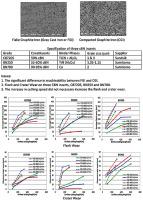International Journal of Machine Tools and Manufacture ( IF 14.0 ) Pub Date : 2020-03-17 , DOI: 10.1016/j.ijmachtools.2020.103539 D. Nguyen , S. Tooptong , K.-H. Park , P. Kwon

|
Among many cast irons, compacted graphite iron (CGI) has recently been gaining more attention due to its superior mechanical properties over the currently more popular flake graphite iron (FGI), aka gray cast iron. However, the poor machinability has prevented CGI to be used in a wider range of potential applications. The resulting tool life difference between FGI and CGI is staggeringly different to be simply explained by the difference in their physical properties. In particular, the excellent machinability of FGI is claimed to be due to the presence of the MnS layer at the interface between cubic boron nitride (cBN) inserts and FGI at high cutting speed. This paper presents the results of our experimental investigation in an attempt to explain the tool wear difference between FGI and CGI while reexamining the formation of such layers. Straight turning experiments were performed with both FGI and CGI with various cBN inserts in dry condition at high cutting speeds (mostly >400 m/min). The flank and crater surfaces of the inserts during turning experiments were investigated and the difference in both flank and crater wear among various cBN inserts are reported as a function of cutting speed. When turning FGI, speckles of MnS, not as a layer, were present based on our EDS/SEM measurement on the cBN inserts, mainly from the MnS inclusions in FGI smearing on the cBN inserts. However, the total area of MnS speckles did not increase as the turning process continues, questioning the formation of the extensive MnS layer protecting the inserts. When turning CGIs, both Mn and S were present individually, not as MnS, on the cBN inserts. Intriguingly, instead of MnS layer, the extensive Al2O3 layer is formed on the rake side on the certain grades of cBN inserts with the Al2O3 binder phase when cutting at high cutting speeds, which functions as the solubility barrier for certain grades of cBN inserts. The crucial difference between FGI and CGI is that the Al2O3 layer is not only larger in coverage but also significantly more stable after turning FGI. Therefore, the tool wear difference between FGI and CGI mainly comes from the formation of the stable Al2O3 layer on the cBN inserts with Al2O3 binder phase when turning FGI. A few additional mechanisms are introduced to make the complete argument behind the remarkable difference in tool wear.
中文翻译:

车削铸铁中立方氮化硼镶块的氧化铝层形成机理。
在许多铸铁中,与目前流行的片状石墨铁(又名灰铸铁)相比,压缩石墨铁(CGI)因其优越的机械性能而受到越来越多的关注。但是,可加工性差使得CGI无法在更广泛的潜在应用中使用。FGI和CGI之间产生的刀具寿命差异惊人地不同,可以通过其物理特性的差异简单地进行解释。特别地,据称FGI的出色可加工性是由于在高切削速度下立方氮化硼(cBN)刀片和FGI之间的界面处存在MnS层。本文介绍了我们的实验研究结果,试图解释FGI和CGI之间的刀具磨损差异,同时重新检查了此类层的形成。在干燥条件下,以高切削速度(大多数> 400 m / min),用各种cBN刀片对FGI和CGI进行了直车削实验。研究了车削实验过程中刀片的侧面和凹坑表面,并报告了各种cBN刀片之间的侧面和凹坑磨损差异是切削速度的函数。根据我们在cBN刀片上进行的EDS / SEM测量,当转动FGI时,存在MnS斑点,而不是一层,主要来自cBN刀片上FGI中的MnS夹杂物。然而,随着车削过程的继续,MnS斑点的总面积没有增加,这对保护刀片的广泛MnS层的形成提出了质疑。车削CGI时,在cBN刀片上Mn和S都单独存在,而不是MnS。有趣的是,代替MnS层,当以高切削速度切削时,在某些等级的具有Al 2 O 3粘结相的cBN刀片的前侧上形成2 O 3层,这对某些等级的cBN刀片具有溶解性屏障的作用。FGI和CGI之间的关键区别在于,Al 2 O 3层不仅覆盖范围更大,而且在转向FGI之后也明显更稳定。因此,FGI和CGI之间的刀具磨损差异主要来自在带有Al 2 O 3的cBN刀片上形成稳定的Al 2 O 3层转向FGI时的粘结相。引入了一些其他机制,以对刀具磨损的显着差异做出完整的论证。


























 京公网安备 11010802027423号
京公网安备 11010802027423号